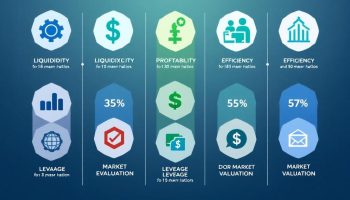
Understanding Business Impact Analysis
Business impact analysis determines how potential disruptions affect your organization’s critical operations. This systematic process evaluates the consequences of business interruptions to protect your essential functions. By identifying vulnerabilities across systems, personnel, and third-party relationships, you’ll establish priority restoration sequences and maintain operational stability during crises.
Key Takeaways
- Business impact analysis provides objective insights into critical business functions and their potential recovery requirements.
- The analysis helps quantify financial, operational, legal, and reputational impacts of potential disruptions.
- Identifying Recovery Time Objectives (RTO) and Maximum Tolerable Downtime (MTD) are crucial for effective resilience planning.
- Cross-functional collaboration is essential for accurate and comprehensive impact assessment.
- Regular review and updates of the business impact analysis ensure ongoing organizational preparedness.
A thorough business impact analysis creates the foundation for your disaster recovery planning. The results directly inform how quickly you need to restore services after an incident. The assessment process involves stakeholders from across your organization to accurately capture dependencies between departments.
Financial impacts often receive immediate attention, but your analysis should also consider customer satisfaction, regulatory compliance, and brand reputation. Each critical function needs specific recovery targets based on its importance to daily operations.
Complex Risks in Modern Business
Modern businesses face increasingly complex risks from cybersecurity threats, supply chain vulnerabilities, and extreme weather events. Your business continuity management strategy depends on accurate impact assessments to allocate resources effectively during crisis response.
Technology Dependencies
Technology dependencies require special attention in your analysis. Cloud services, third-party data processors, and remote work capabilities all present unique recovery challenges. Document these dependencies carefully to avoid overlooked recovery requirements.
Leadership Support
Senior leadership must support the business impact analysis process to ensure appropriate participation across departments. Their involvement validates the importance of this work and secures resources for implementation of the continuity planning recommendations that emerge from your analysis.
“Business impact analysis serves as a vital compass, illuminating the pathway to resilience by meticulously assessing how potential disruptions could jeopardize an organization’s critical operations. By uncovering vulnerabilities and establishing priority restoration strategies, organizations can not only safeguard their essential functions but also fortify their reputation and stability in times of crisis.”
Understanding Business Impact Analysis
Business impact analysis is best used for determining how potential disruptions affect your organization’s critical operations. This systematic process evaluates the consequences of business interruptions, identifying vulnerabilities across your systems, people, and third-party relationships. A comprehensive BIA determines priority restoration sequences for critical functions, ensuring your organization maintains operational stability during crisis situations.
You’ll gain valuable insights by implementing a thorough BIA, which serves as the foundation for effective risk response strategies. The analysis helps you understand which processes can’t tolerate extended downtime, allowing you to allocate resources appropriately.
Critical Function Identification
The first step in your BIA involves identifying business-critical activities that cannot withstand prolonged downtime. Business impact analysis is best used for determining which functions need immediate recovery by assessing potential impacts across multiple dimensions:
- Financial consequences (revenue loss, penalty costs)
- Operational disruptions (production delays, customer service impacts)
- Legal and compliance issues (regulatory violations, contractual breaches)
- Reputational damage (customer confidence, brand perception)
You must quantify both direct financial losses and long-term strategic implications when conducting your analysis. This helps establish crucial recovery parameters like Recovery Time Objectives (RTO) and Maximum Tolerable Downtime (MTD).
When collecting data, conduct your analysis at the department or business unit level using multiple information-gathering techniques:
- Structured interviews with key personnel
- Targeted surveys for broader input
- Cross-functional workshops to identify interdependencies
- Review of existing documentation and processes
Business impact analysis is best used for determining resource requirements during recovery efforts. Your data collection should focus on function interdependencies, specific resource needs, and acceptable downtime thresholds. Always validate findings across teams to ensure accuracy.
The most effective BIAs examine various potential disruption scenarios, including physical facility damage, equipment failures, supply chain interruptions, and IT outages. Your analysis should highlight how impacts vary by sector and demonstrate how recovery priorities might shift depending on timing.
After completing your assessment, create a comprehensive BIA report with an executive summary, detailed departmental findings, financial assessments, and recovery recommendations. Your communication strategy should ensure findings reach senior management and key stakeholders. Plan for periodic reviews and updates, especially after major organizational changes.
Business impact analysis is best used for determining how to enhance your organization’s resilience through informed decision-making, improved recovery preparedness, and regulatory compliance support.

Identifying Critical Business Processes
Your organization’s survival during disruptions hinges on correctly identifying which processes can’t afford extended downtime. Business impact analysis is best used for determining which functions need priority restoration and protection. This systematic evaluation helps you quantify potential losses and establish recovery timeframes that align with business objectives.
When identifying critical processes, you need to examine both the immediate financial impacts and long-term strategic consequences. Start by creating a comprehensive inventory of all business functions across departments, then evaluate each against specific criteria including:
- Financial impact (revenue loss, penalties, additional expenses)
- Operational impact (ability to deliver products/services)
- Legal and regulatory consequences
- Reputational damage
- Customer satisfaction effects
The most valuable outcome from this identification process is establishing clear recovery parameters. You’ll need to determine two critical measurements:
- Recovery Time Objective (RTO): The maximum acceptable time a process can be unavailable
- Maximum Tolerable Downtime (MTD): The absolute maximum time a function can be offline before causing irreparable harm
The relationship between these metrics helps prioritize your risk response strategies and resource allocation decisions. When comparing processes, consider dependencies between functions – many critical processes rely on seemingly less important supporting activities.
Process Prioritization Framework
To effectively prioritize processes, you’ll need a structured approach. The following table outlines a practical classification system:
| Priority Level | Characteristics | Recovery Timeframe | Example Functions |
|---|---|---|---|
| Critical | Direct revenue impact, legal requirements | 0-24 hours | Payment processing, emergency services |
| Essential | Significant operational impact | 24-72 hours | Customer service, supply chain operations |
| Important | Needed for full operations | 3-7 days | Reporting, non-essential manufacturing |
| Non-critical | Minimal short-term impact | 7+ days | Training, administrative functions |
This prioritization becomes the foundation for developing your disaster recovery plan. Remember that business impact analysis is best used for determining not just what to recover, but in what order to restore functions.
During this identification process, leverage cross-functional teams to validate assumptions. Department heads may overestimate their function’s criticality, so objective evaluation criteria are essential. Consider conducting workshops with representatives from different business areas to create consensus on priorities and recovery requirements.
Expert Insight: Identifying critical business processes is essential for ensuring your organization’s resilience during disruptions. Start by conducting a comprehensive business impact analysis that assesses financial, operational, legal, and reputational implications, thereby helping you prioritize recovery efforts based on Recovery Time Objective (RTO) and Maximum Tolerable Downtime (MTD). Engage cross-functional teams for objective evaluations to prevent overestimations of criticality and foster consensus in determining which processes are vital for business continuity.
Methodology and Data Collection Approach
Conducting a thorough business impact analysis is best used for determining your organization’s true resilience capabilities. Your BIA methodology should be structured at the department or business unit level to capture specific operational nuances. This approach ensures you don’t miss critical dependencies that could undermine recovery efforts.
When gathering data for your business impact analysis, you’ll need multiple collection techniques to build a comprehensive picture. Begin with structured surveys to establish baseline information about each department’s functions. These surveys help business impact analysis is best used for determining which areas require deeper investigation.
Information Gathering Techniques
Your data collection process should incorporate these complementary approaches:
- One-on-one interviews with department leaders and subject matter experts
- Cross-functional workshops to identify hidden interdependencies
- Documentation reviews of existing process flows and system maps
- Structured questionnaires targeting specific operational vulnerabilities
- Observational assessments of critical work areas
Each technique offers unique insights that strengthen your risk assessment capabilities. Workshops particularly excel at revealing dependencies that individual department leaders might overlook.
For your information collection, focus on gathering these essential data points:
- Detailed descriptions of core business functions and processes
- Required resources (people, systems, facilities, vendors)
- Acceptable downtime thresholds before significant impacts occur
- Interdependencies between business functions
- Regulatory or contractual obligations with time-sensitivity
- Financial impact estimates for various outage durations
- Historical incidents and their operational impacts
The quality of your collected data determines how effectively business impact analysis is best used for determining recovery priorities. Always validate findings through cross-functional reviews where key stakeholders can challenge assumptions and identify gaps.
Remember that your BIA methodology must account for different impact types—not just financial losses but also reputation damage, customer retention issues, and regulatory compliance risks. These qualitative factors often prove more significant than immediate financial considerations when business impact analysis is best used for determining true organizational priorities.
Companies that invest in resilience planning achieve a 25% decrease in downtime, leading to substantial cost savings and operational continuity.
forbes.com
Disruption Scenario Analysis
Examining potential interruption scenarios is where business impact analysis is best used for determining your organization’s ability to withstand and recover from various threats. Your BIA process must systematically analyze how different disruption types could affect your operations differently.
Physical Facility Damage
Physical facility damage scenarios require you to evaluate the loss of workspace, equipment, and physical assets. Consider both partial and complete building inaccessibility situations. You’ll need to determine whether remote work options exist and what critical equipment must be replaced immediately versus what can wait.
IT System Outages
IT system outages represent perhaps the most common disruption modern organizations face. Your analysis should differentiate between temporary outages, prolonged downtime, and catastrophic data loss scenarios. Each critical application needs a clearly defined recovery time objective based on your risk tolerance levels and operational requirements.
Supply Chain Disruptions
Supply chain disruptions have become increasingly prevalent, making their inclusion in your BIA essential. Analyze single-supplier dependencies, transportation network vulnerabilities, and inventory depletion timelines. Business impact analysis is best used for determining which vendors require backup sources and which products or components need enhanced inventory buffers.
Industry-Specific Impacts
Different industries experience unique impact variations that your analysis must address:
- Financial services organizations typically face severe impacts from even brief technology outages.
- Manufacturing companies may tolerate longer IT disruptions but cannot withstand production stoppages.
- Healthcare providers must maintain continuous operations with minimal tolerance for downtime.
- Retail businesses experience varying impacts based on seasonality and sales cycles.
Timing of Disruptions
The timing of disruptions significantly affects recovery priorities. Your risk response planning should account for how the same incident might require different responses depending on when it occurs. For example, payroll system failures are catastrophic near payment processing dates but may be manageable at other times.
According to Gartner, organizations that invest in business continuity planning and disruption scenario analysis can expect to see a 50% reduction in recovery time during incidents.
gartner.com
Reporting and Communication Framework
A well-structured reporting framework is essential when presenting business impact analysis findings. Business impact analysis is best used for determining critical recovery priorities and resilience strategies that require clear communication to all stakeholders. Your BIA report should include an executive summary that provides a high-level overview of key findings and recommendations without overwhelming executives with technical details.
The comprehensive BIA report should contain detailed departmental findings that outline specific vulnerabilities, dependencies, and recovery requirements for each business function. These sections must clearly articulate Recovery Time Objectives (RTOs) and Maximum Tolerable Downtime (MTD) parameters that have been established for critical processes.
Your financial impact assessments should quantify potential losses using:
- Direct revenue losses during outages
- Indirect costs from recovery activities
- Long-term customer and market share impacts
- Contractual penalties or regulatory fines
- Productivity and opportunity costs
When communicating BIA results to senior leadership, you’ll need a targeted approach that emphasizes business continuity implications. Business impact analysis is best used for determining which functions require immediate recovery funding and resource allocation during disruptions.
Effective Communication Strategies
The communication of BIA findings should follow a structured distribution plan. You should schedule dedicated presentations for different stakeholder groups with content tailored to their specific interests and responsibilities. Business impact analysis is best used for determining communication priorities during crisis situations.
A well-designed strategic dashboard can help visualize complex BIA data for leadership reviews. This creates a foundation for ongoing dialogue about organizational resilience. You should establish a regular review cycle to maintain the accuracy of your BIA – typically annual reassessments for high-volatility industries or biennial for stable organizations.
After major organizational changes like mergers, acquisitions, or new product launches, your BIA should be immediately updated to reflect new business realities. Remember that effective project communication of BIA findings is crucial for gaining leadership support for recommended resilience investments.
Business impact analysis is best used for determining which stakeholders need what information during both planning and crisis response phases. Your communication approach should acknowledge that different audiences require varying levels of detail, from executive summaries to comprehensive technical documentation for implementation teams.
Strategic Benefits and Implementation
Business impact analysis is best used for determining how your organization should allocate resources during a disruption. When properly implemented, a BIA provides clear insights into which business functions require immediate restoration and which can tolerate longer downtime periods.
The strategic advantages of conducting regular business impact analyses extend far beyond basic compliance. You’ll gain a comprehensive understanding of your operational vulnerabilities, allowing for targeted investments in resilience measures. Business impact analysis is best used for determining critical dependencies between departments that might otherwise remain hidden until a crisis occurs.
Key Strategic Benefits
A well-executed BIA delivers several critical advantages to your organization:
- Prioritized recovery efforts based on objective data rather than assumptions
- Clear visibility into interdependencies between business functions
- Improved regulatory compliance posture for industries with resilience requirements
- Enhanced stakeholder confidence through demonstrated preparedness
- Optimized budget allocation for business continuity measures
Implementing your BIA requires a structured approach to maximize its effectiveness. Start by securing executive sponsorship to ensure adequate resources and participation. Business impact analysis is best used for determining which risk response strategies will deliver the greatest protection for your most vulnerable operations.
For optimal results, conduct your BIA every 18-24 months or following significant organizational changes like mergers, new product lines, or major system implementations. This frequency ensures your resilience strategies remain aligned with your evolving business priorities.
Effective implementation also depends on cross-functional participation. Ensure representatives from all business units contribute to the analysis process. This collaborative approach helps identify hidden dependencies that might otherwise be missed during disaster recovery planning.
The most successful BIA implementations link directly to your organization’s strategic goals. When business impact analysis is best used for determining resilience investments, you’ll notice improved alignment between continuity efforts and business priorities. This alignment transforms your BIA from a compliance exercise into a strategic advantage that strengthens overall organizational performance during both normal operations and crisis situations.






